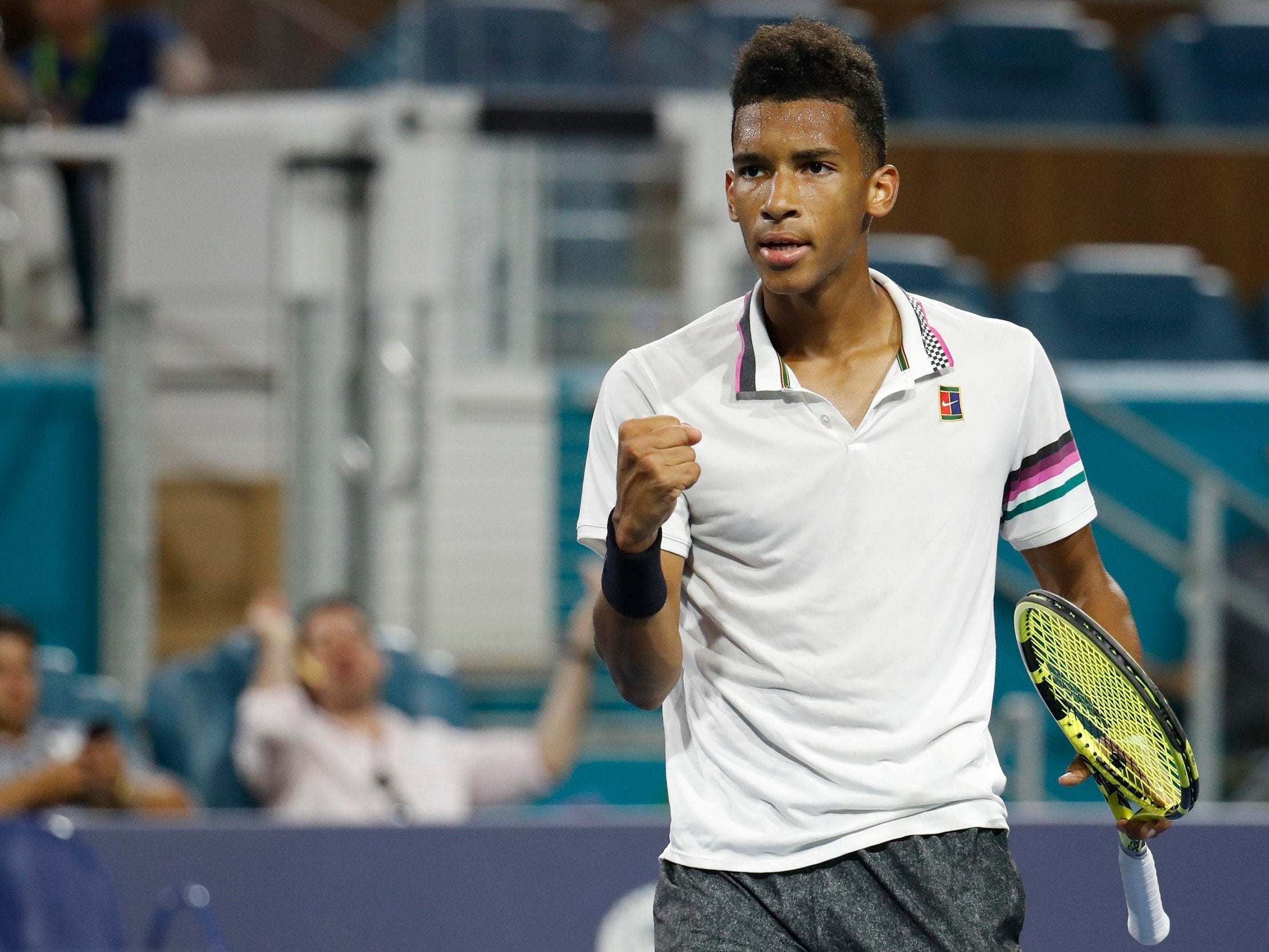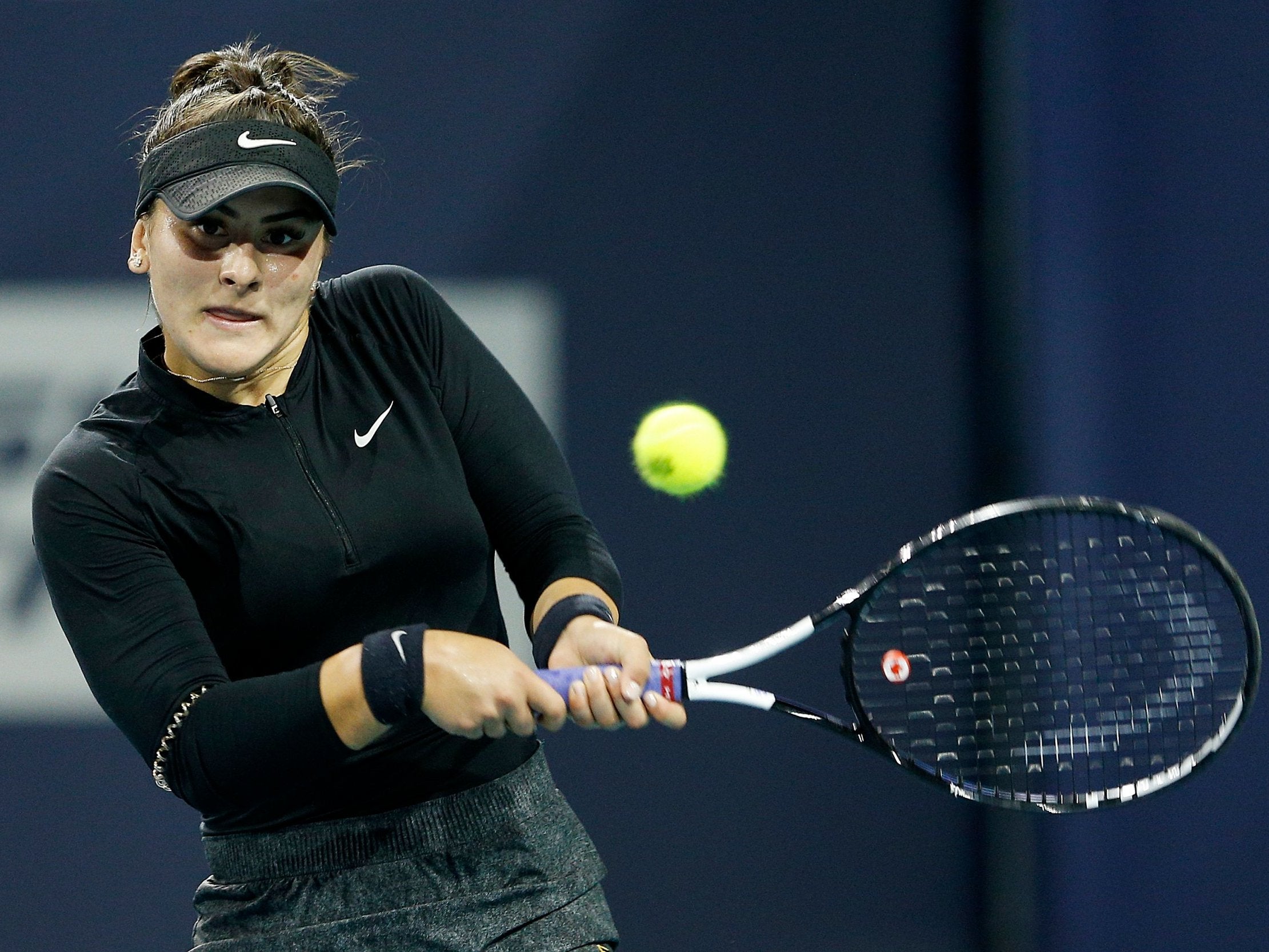Why tennis prodigies Bianca Andreescu and Felix Auger-Aliassime give me faith in the future of the planet and everyone in it
This week’s column is about the future. It’s about the next generation. It’s about joy, and where you find it. It’s about hope, and how you hold on to it

Your support helps us to tell the story
From reproductive rights to climate change to Big Tech, The Independent is on the ground when the story is developing. Whether it's investigating the financials of Elon Musk's pro-Trump PAC or producing our latest documentary, 'The A Word', which shines a light on the American women fighting for reproductive rights, we know how important it is to parse out the facts from the messaging.
At such a critical moment in US history, we need reporters on the ground. Your donation allows us to keep sending journalists to speak to both sides of the story.
The Independent is trusted by Americans across the entire political spectrum. And unlike many other quality news outlets, we choose not to lock Americans out of our reporting and analysis with paywalls. We believe quality journalism should be available to everyone, paid for by those who can afford it.
Your support makes all the difference.A couple of weeks ago, for what felt like the umpteenth time, Theresa May’s cabinet descended into chaos over the prime minister’s deadlocked deal and the prospect of a third meaningful vote being brought back to the House of Commons. That was a Saturday. On the Sunday, the world No60 Bianca Andreescu came back from a break down against Angelique Kerber in the final set to win her first major WTA title at Indian Wells.
This week, a study in a respected medical journal concluded that climate change would put 500 million people living in non-tropical regions like northern Europe at risk of contracting mosquito-borne diseases like Zika, dengue and yellow fever. That was a Wednesday. On Thursday, Félix Auger-Aliassime became the first teenager to reach the semi-finals in the 35-year history of the Miami Open.
This week’s column is about the future. It’s about the next generation. It’s about joy, and where you find it. It’s about hope, and how you hold on to it.
---
Bianca Andreescu is 18 years old. Not since Serena Williams, two decades ago, has a female player that young won one of the WTA’s Premiere Mandatory events. But then, very little about Andreescu’s story screams normality. For one thing, the Canadian has never set foot in a high school. The demands of a blooming tennis career forced her to complete her studies online. Unlike most young women of her age, her days consist of ice baths and physio, of meditation and hot yoga. During matches, she occasionally sniffs a mysterious potion from a clear jar at changeovers. She’s never said what it is.
At the start of the year, she was ranked No152 in the world, and anybody who had heard of her then has probably been boring you about it ever since. Next Monday’s update will put her at No23. Those in the know suggest it will go considerably higher than that. She’s powerful off both wings, with two heavy serves and a delightful drop shot, and yet on the early evidence, none of this is what’s most impressive about her. She has this uncanny ability to read an opponent like a road sign, and play the shot they’re least expecting her to hit at that exact moment. And already, in these short few weeks, she’s shown reserves of resolve well beyond her years.
To get to the Indian Wells final, she had to negotiate a tough draw including a double Grand Slam winner and the world No6. Then, in the world’s second-largest tennis stadium, limping and exhausted after six straight matches, with her arms and shoulders and back strapped up like a broken child’s toy, she was broken by the Wimbledon champion Kerber to go 3-2 down in the final set. She summoned her coach Sylvain Bruneau down from the stands. “I’m tired,” she told him. “My feet are burning. I can barely move.”
“You have to push through,” Bruneau replied. He reminded her of everything she had been through to reach that point. He asked her how much she wanted it.
“I really want this,” she replied.
With the crowd roaring her on, Andreescu smashed through the pain barrier and smashed down the Kerber wall, breaking the German three times to claim the title. Whereupon, she reverted to being an awestruck teenager once more. “Can I say the F-word?” she giggled during her press conference. “No, I can’t. The effing champion of Indian Wells. It’s crazy. Just crazy.”
---
Felix Auger-Aliassime is waiting in the wings, standing in the concrete tunnel that leads out to the Indian Wells arena. He, too, is only 18 years old, and for all his achievements at junior level, he’s not yet old enough or famous enough to be able to ignore a camera when it’s being pointed right in his face. As he waits to be called onto court, his eyes occasionally dart nervously left, towards the camera, then nervously back as he remembers he’s supposed to be in the zone.

Like most teenagers, he’s still not of an age where he’s learned to lock his heart away. Last autumn, playing his friend and fellow Canadian Denis Shapovalov in the first round of the US Open, he was forced to retire after developing heart palpitations. As the awful realisation dawned on him that his first ever Grand Slam match would end with an ‘R’ alongside his name, he crumpled into his opponent’s arms and cried like a baby. “Keep your head up, man,” Shapovalov assured him. “You did f---ing well. You’re gonna have everything.”
Yet even Shapovalov probably didn’t expect ‘everything’ to come this quickly. Yes, Auger-Aliassime was a prodigy at youth level, winning three senior titles before the age of 17 and becoming the youngest player to break the top 200 since Rafael Nadal. But the recent chronicles of men’s tennis are strewn with promising junior players who couldn’t sustain their vertiginous early trajectory. Boosted by improved standards of fitness and professionalism, as well as the bed-blocking brilliance of the Big Four, the average age of the top 100 has been steadily rising since the 1990s. The era of the teenage tearaway appeared to be over.
Brick by brick, Auger-Aliassime is chipping away at the edifice. Ranked No108 at the start of the year, he has cut a swathe through the men’s tour. After reaching his first ATP final in Rio in February, this week in Miami he has stormed to the semi-finals, where he will play the giant flesh scarecrow John Isner late on Friday night. Already, he’s on the fringes of the world’s top 32. His record against top-20 players, meanwhile, is spectacular. He’s played five, and won all five. He is, let’s remember, just 18 years old.
But to truly get excited about Auger-Aliassime, you need to watch him. Often it’s said of great players that they seem to have all the time in the world. There are times when Auger-Aliassime looks like he’s out of the point: he’s left himself too much to do, he’s out of options. Then, with a lightning burst of pace, or a scintillating whip of the wrists, the ball’s disappearing into the opposite court at twice the speed it left. Like Andreescu, he’s got two strong serves and a killer drop shot, but it’s when scampering around the baseline, bending time to his will, that he’s at his most thrilling. “I want to feel all the emotions I can feel,” he said recently when asked about his ambitions in tennis, and you can sense that in the way he soaks up every last drop of a point, takes every last split second he can, secure in the knowledge that when the ball finally leaves his racquet, there’s a strong chance it’s not coming back.
---
The fact that Andreescu and Auger-Aliassime are both Canadian is, in many ways, the least interesting thing about them. Like so many of their generation, they’re a product not of one culture, of one system, of one blood, but of many. Andreescu spent part of her childhood in Romania, and after her Indian Wells victory delighted the few Romanian fans in the crowd by addressing them in their native tongue. Auger-Aliassime is mixed-race, the son of a Togolese father and a Quebecois mother, his speed the partial legacy of a childhood spent playing football as a winger. Canada will happily claim them both – as they do Shapovalov, born in Israel to Russian parents. But in a way, they’re citizens of a very modern world.

There’s always been a vaguely irrational thrill in witnessing the emergence of a young prodigy, whether in sport or art or anything else. Partly it’s the natural human fetishisation of that which is fresh over that which is familiar, the shiny new thing over the weathered old. Partly it’s the simple pleasure of projection and extrapolation, of seeing generations and worlds brush up against each other for the first time. Occasionally the established faces, sensing the impending threat and perhaps affronted by the implied twang of their own mortality, kick back. “You are the biggest drama queen ever,” a visibly irritated Kerber snapped at Andreescu last weekend after losing to her in Miami for the second time in a week.
But somehow, right now, it feels like there’s more to it than that. At this particular moment in time – a time of cynicism and fatigue, in a world tearing itself apart and a culture of screaming mayhem – then even something as frivolously trite as sport possesses its own redemptive power. Quietly, against the backdrop of a political wrangle populated by all the same old faces – the ATP, the ITF, the Grand Slams, the leading players – tennis has become more exciting than it’s been in years. New names are making big strides: Naomi Osaka, Aryna Sabylenka, Belinda Bencic, Amanda Anisimova in the women’s game, Stefanos Tsitsipas, Borna Coric, Shapovalov and Francis Tiafoe on the men’s. For the first time in more than a decade, a new world seems possible.
Needless to say, I have no idea what Andreescu or Auger-Aliassime think about climate change. What they know or care about the generation above them who have broken their futures against the wheel of hard greed. Perhaps it’s hopelessly, stupidly idealistic to imagine the kids will save us. But last weekend I marched in London alongside a bunch of teenagers from Oxfordshire who were optimistic and exuberant and utterly furious about Brexit. Recently, I saw a 16-year-old girl called Greta Thunberg speaking on television about climate change, about the school protests that have spread to every continent on Earth, mobilising the younger generation in new ways and on an unprecedented scale. And on Friday night, I’ll tune in to watch an 18-year-old tennis prodigy playing a 33-year-old big-serving veteran, trying to reach his first Masters final. In a way, it’s their world now. All they have to do is take it.
Join our commenting forum
Join thought-provoking conversations, follow other Independent readers and see their replies
Comments